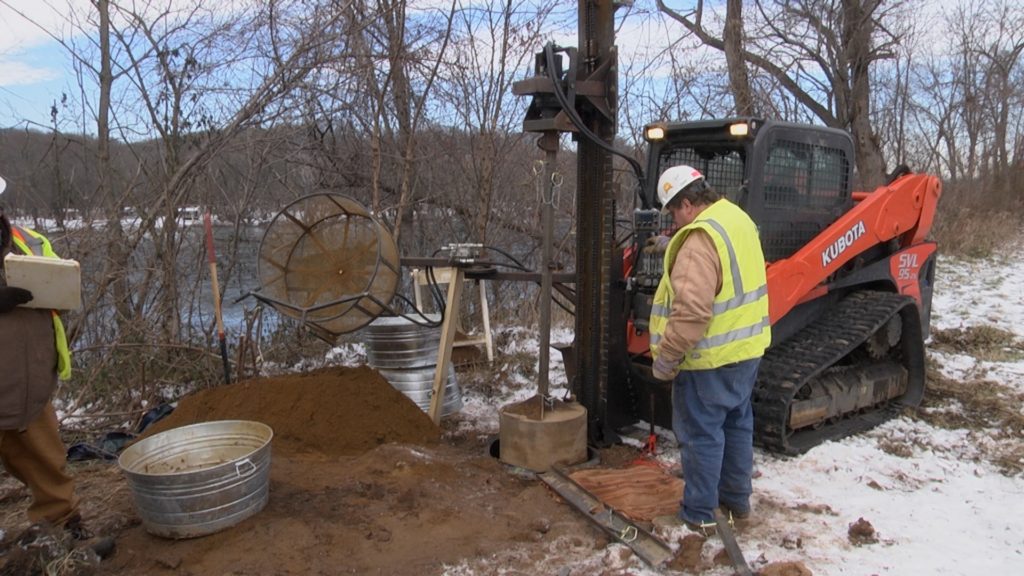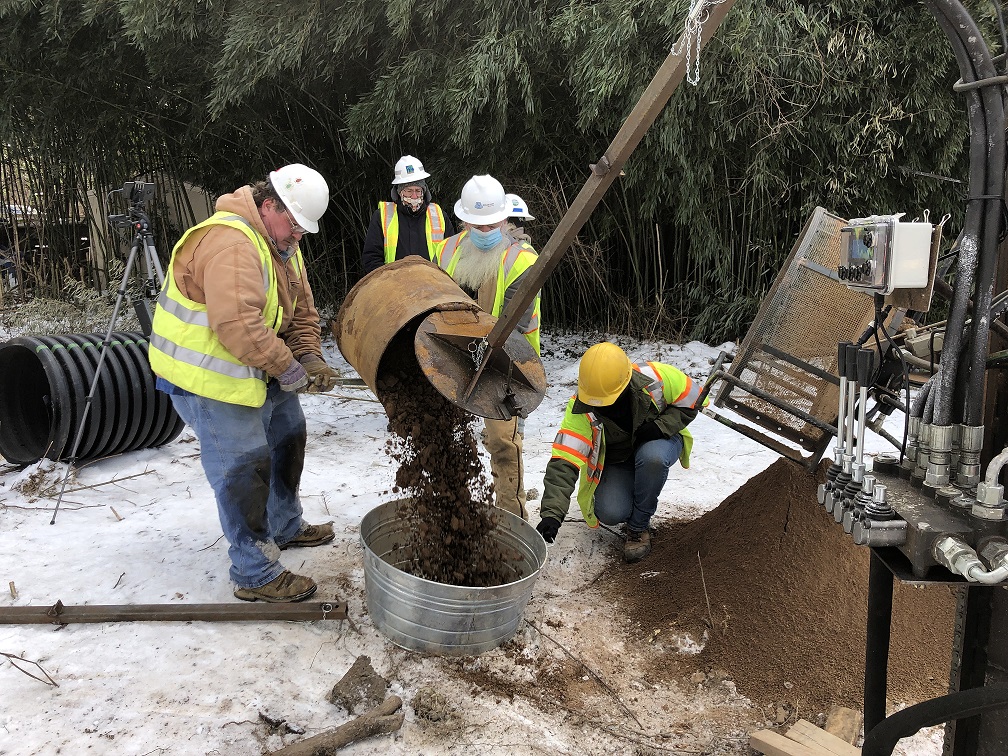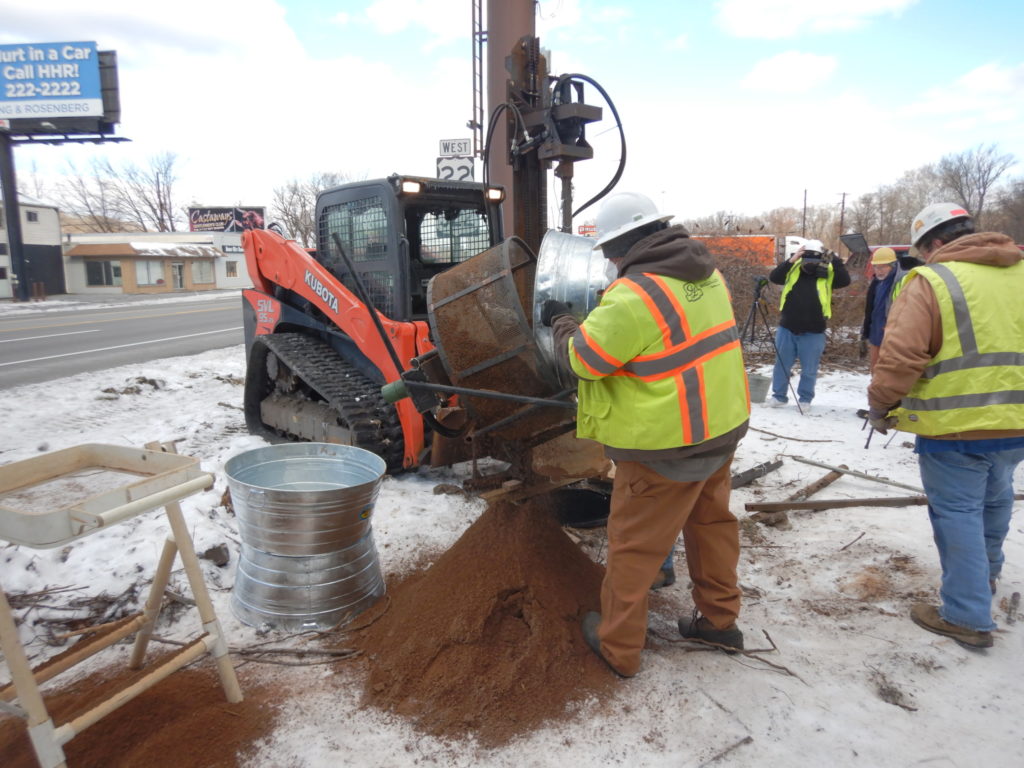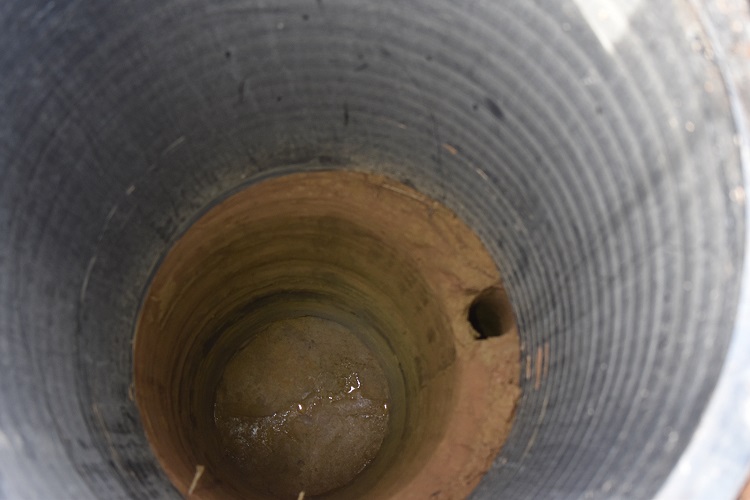October is Archaeology Month! Today’s post by Guest Contributor PennDOT archaeologist Steve McDougal covers using a non-traditional method for field tests: the Paleo-Digger.
Every archaeological survey poses different conditions and challenges. For PennDOT’s SR 22/322 safety improvement project in Northern Dauphin County, one of the big challenges is the depth of soils involved. Past excavation in the 1990s for this area showed us that the soil column with archaeological potential could extend 3.5 to 4.5 meters (11.5 to 14.75 feet) in depth below current ground surface.
Traditional methods for Phase I deep testing consist of excavation of 1 by 1 meter (3.28 by 3.28 foot) test units. These units can be safely excavated to a depth of 1.52 meters (5 feet) by OSHA standards to prevent wall collapse and safety hazards to the field crew doing the excavation. Excavation beyond 1.52 meters entails either shoring or stepping back the test units.
Both of these options have their concerns. Shoring can be time consuming and costly and excavating in a shored unit is still not without risk. Stepping back test units is also time consuming and, for the depths we are dealing with for this project, would involve excavating large areas on the top of the soil column to get to a 1 by 1 meter unit at the bottom. That amount would be out of scope for a Phase I survey and would look more like a Phase II or Phase III. One excavation phase at a time, thank you very much!
The project archaeological contractor (Skelly and Loy) recommended using a specialized auger machine, called the Paleo-digger, made by Brian Fritz of Quemahoning Cultural Resource Management Services, to safely and expeditiously complete Phase I excavation.

The Paleo-digger is a two foot wide mechanical auger attached to a small excavator. It can accurately excavate in 10 cm levels which is consistent with test unit excavation. There is a rotating plate at the bottom of the auger which holds the excavated soil in place (the auger is rotated the opposite direction of digging after a level is dug to slide it in place). After coming out of the ground, the auger bucket is emptied into a separate bucket.

The soil is then run through a revolving circular screen to look for artifacts. Any soil that does not go through this screen is run through a standard shaker screen.

The auger had been successfully tested prior to this project by Brian Fritz to the depths necessary for our project; however, it had not been previously used in CRM or for a PennDOT project. Archaeologists are generally hesitant to use mechanical means in place of hand excavation when working through intact soil horizons.
By its very nature, archaeology is a destructive process and, as a result, field methodology needs to be carried out in a careful, methodical, and thoughtful manner.
Discussions and consultations were undertaken within PennDOT and with the Federal Highway Administration, the State Historic Preservation Office, Native American Tribes and Nations, and interested consulting parties. The main issue was the presence of archaeological features that could be impacted by the auger. We decided to excavate test units to OSHA depth and assess at that point. If there was no or low potential for features below OSHA depth, then it was felt it would be safe to use the Paleo-digger.
Preliminary geomorphological reconnaissance showed a level of fill roughly 1 meter deep followed by intact alluvial soils. Available shoring boxes are 8’ x 8’ (2.4 m x 2.4m) so we mechanically removed fill to those dimensions and installed a shoring box. Test units were excavated in the middle of the shored areas to OSHA depth. We recovered artifacts in most of the test units. Material at the base of the test units was from the Archaic period. At this point, features were not expected.
For the first use of the machine, we focused on two test units on the periphery of the site. These two test units were backfilled with the exception of a 2 foot wide plastic pipe (the width of the auger) that was put in the middle of the test units. This provided a casing for the auger and the backfilled area provided a stable ground surface to work on. Excavation took place in early January 2022. Work proceeded slowly at first, but sped up as the field crew got used to using the machine.
We did not find much in two days use of the machine, but we did find a chert flake in one unit at 3 meters depth. The maximum excavation in this effort was stopped in basal river sands at 450 cm below ground surface. The sides of the auger hole held up well with no slumping or cave-ins.

Here are some preliminary thoughts on using the Paleo-Digger…
From the initial use of this machine, it seems that it has good potential for deep testing in tandem with test unit excavation. I personally don’t think this is a substitute for test unit excavation, especially if there is the potential for features. However, for deep testing below OSHA depth where features are not reasonably expected, this field methodology has very good potential. The amount of soil excavated is not equal to that of a test unit, but it is enough to answer the question of presence or absence of an archaeological site.
Further, it is a larger sample than would be excavated in a more traditional approach of putting a shovel test in the bottom of a test unit to get down to two or two and a half meters. As evidenced by recovery of a flake at 3 meters below ground surface, it is sufficient to detect presence or absence of archaeological material which is the point of a Phase I archaeological survey.
Based on the successful trial use of this machine, I look forward to using it again.
Learn more about the Paleo-Digger by listening to this podcast.
Today’s post is by Guest Contributor Steve McDougal. Steve is the PennDOT CRP archaeologist for Districts 5-0 and 8-0.
Comment Policy
PHMC welcomes and encourages topic-related comments on this blog. PHMC reserves the right to remove comments that in PHMC’s discretion do not follow participation guidelines.
Commenters and Comments shall be related to the blog post topic and respectful of others who use this site.
Commenters and Comments shall not: use language that is offensive, inflammatory or provocative (this includes, but is not limited to, using profanity, obscene, or vulgar comments); disparage other commenters or people; condone illegal activity; identify the location of known or suspected archeological sites; post personal information in comments such as addresses, phone numbers, e-mail addresses or other contact details, which may relate to you or other individuals; impersonate or falsely claim to represent a person or an organization; make any commercial endorsement or promotion of any product, service or publication.
If you would like to comment on other topics not related to this blog post but related to PHMC, please fill out the PHMC Contact Us Form.

Very interesting use of mechanical equipment.